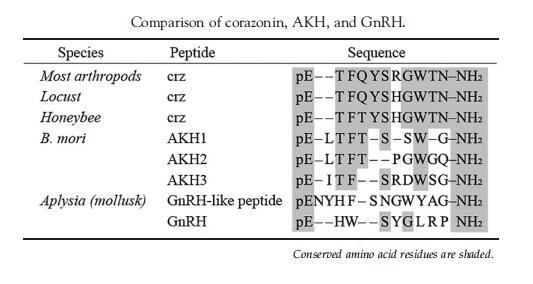| Questions And Answer | Back Directory | [Description]
A highly conserved neuropeptide produced by the central nervous system in insects, crustaceans, and ticks, CRZ has been implicated in controlling different species- and stage-specific functions. | [Structure]
Corazonin is a very conserved N-terminally blocked undecapeptide amidated at the C-terminus. The aa sequence is conserved in all examined arthropods (insects, crustaceans, and ticks). Corazonin is distantly related to the vertebrate gonadotropin�releasing hormone (GnRH) and the GnRH-like peptide from mollusks. | [Properties]
Corazonin:Mr 1350–1370; soluble in water, physiological saline, and 50%–70% methanol or ethanol. | [Regulation of synthesis and release]
Corazonin expression appears to be constitutive. In locusts, external environmental conditions such as high population density and low temperature seem to elicit corazonin secretion from the CC.In D. melanogaster, corazonin is centrally released from the abdominal interneurons during mating. | [Discovery]
Corazonin was isolated as a cardioactive peptide from the corpora cardiaca (CC) of the cockroach Periplaneta americana, and subsequently identified in many arthropods. This neuropeptide controls cuticle melanization in locusts and crayfish, initiation of the ecdysis sequence in moths, and modulation of stress responses and male reproduction in flies. | [Biological functions]
Corazonin stimulates the heartbeat in P. americana and Rhodnius prolixus in vitro, but is inactive in vivo and in other insects.Corazonin controls eye pigment migration, melanization of the cuticle, and a shift to the gregarious phase in locusts.In the crustacean Procambarus clarkii, it regulates chromatophore migration in the integument. |
|
|